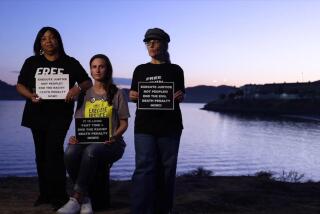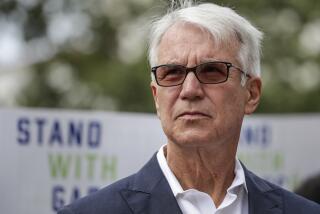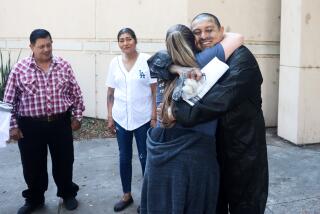False Accusations Scar Boys
CHICAGO — Even now, the mug shots are jarring.
The murder suspect wears a red-and-purple T-shirt with a playful animal design. In one photo, he stares wide-eyed into the camera. In another, he’s in profile, looking anxiously upward, as if something is about to fall on his head.
His height and weight are noted: 4-foot-7 and 70 pounds. But these numbers are overstated, his lawyers say, because police want to make him appear bigger and stronger.
Unlike most people photographed in a police lockup, this suspect has a limited history. He has never held a job. He isn’t even halfway through elementary school.
He’s just 8.
The child, identified in court documents as E.H., was charged, along with his 7-year-old pal, with slaying an 11-year-old girl, Ryan Harris. The case captured national headlines in 1998 as the two became among the youngest children in the nation ever formally accused of murder.
The charges were short-lived and the two boys then turned the tables on their accusers. After seven years, an agreement was reached in civil cases that accused the city and the police of wrongful arrest.
Last month, the city approved a multimillion-dollar settlement of one suit, ordering its lawyers to negotiate an agreement as a jury trial neared its end. An earlier case was resolved out of court.
Nearly $11 million in taxpayer money, including legal fees, has been paid to close what an alderman called “one of the most shameful episodes in our city’s history.”
In settling, the city admitted no wrongdoing. No police were sanctioned.
This was not the first time children have been wrongly accused or reported to have confessed to something they didn’t do.
But this case offers a rare glimpse into how it can happen -- what detectives may say and do behind closed doors, and how a harrowing journey from a police station to the courts and a psychiatric hospital can change the lives of two little boys.
*
When E.H. took the witness stand in August, he didn’t look at the jury.
Nor did he glance at two men sitting at the defense table: Detectives James Cassidy and Allen Nathaniel -- the former retired, the latter still on the force -- who were accused of framing him.
Nearly half his life had passed since news helicopters had buzzed over the boy’s house and he was called a “little killer.”
He was 15, but his voice was barely audible, his attorneys gently coaxing every answer.
He recalled the day when he rode bikes with friends, including Ryan Harris, watched her get into a red car with two men, then ended up in the police station, where he assumed he’d look at photos to try to identify them.
Instead, police surrounded him and showed him a photo of a badly beaten body in a weed-filled lot; Ryan’s panties were jammed down her throat, leaves stuffed in her nostrils.
“They were hollering at me, asking me if I killed her,” the boy told his lawyer, Andre Grant, in a near whisper.
“Did you tell them you killed Ryan Harris?’ Grant asked.
“I said I didn’t do anything,” he answered.
“Were you afraid?”
“Yes.”
The charges against E.H. depended largely on the purported confession of his buddy, identified as R.G., who was questioned separately. According to police, the 7-year-old said he threw a rock at Ryan, and she fell off her bike and hit her head. Then, he allegedly said, he and E.H. dragged her into a wooded area, where R.G. stuffed the girl’s underwear into her mouth.
Attorneys for the boys have long ridiculed that claim, noting R.G. had a serious speech impediment and could barely string two or three words together -- much less a 16-sentence confession.
“To say that he could tell a story from start to finish was patently absurd,” argues Jan Susler, a lawyer for R.G. “The only evidence they had was not believable. ... These two little kids were scared out of their brains.”
It’s not difficult for police officers to shape a kid’s message, says Stephen Ceci, a professor of developmental psychology at Cornell University and an expert on child confessions. “They’re putty in the hands of a powerful adult authority figure.”
“You say to a child who has been in an interrogation room for an hour ... ‘If you only tell me what we already know, you can go home.’ An adult knows that’s not true,” Ceci says. “If you say that to a 7-year-old, they’ll often tell you, ‘I did it.’ They can’t anticipate the consequences of saying yes.”
In this case, the boys were questioned without lawyers or family in the room. Their statements were not recorded. And from the moment they walked out, both denied they’d confessed.
“I didn’t do it, Grandma,” R.G. repeatedly said after the interrogation, during which police held his hand and bought him a Happy Meal and a toy car.
At the time, the detectives, Cassidy and Nathaniel, were praised by police for having “performed magnificently” in cracking what had become a “heater” case, with heavy public and political pressure for an arrest.
Seven years later, at the civil trial, city attorneys called them “fine officers,” justified in their actions -- and noted that other police also thought the boys were responsible for Ryan’s death.
The two men defended their behavior, saying that both boys had implicated themselves and that they thought the kids were trying to take Ryan’s bike. But the detectives also made some troubling admissions.
Cassidy testified that he hadn’t reviewed the files, yet he managed to get a confession on his first day on the case, which dozens of investigators had worked on for weeks.
He acknowledged that E.H., a second-grader, probably didn’t understand his version of Miranda warnings. Cassidy called them “kiddie rights,” which included the admonition: “Good boys don’t lie.”
Cassidy also had been told by a medical examiner -- before the boys were charged -- that Ryan’s injuries weren’t consistent with a thrown rock. She died of a severe beating and asphyxiation.
This wasn’t Cassidy’s first controversy involving a child suspect. In 1994, he said an 11-year-old boy blurted out that he had killed an elderly neighbor. The boy tried to recant but was convicted.
In 2002, a federal judge tossed out the murder conviction, saying the arrest was illegal and the confession coerced. The young man sued; the case was settled out of court.
Nathaniel revealed other inconsistencies.
He admitted that he had never talked with E.H., even though he told a judge in 1998 that the boy told him about seeing his pal throw a rock. Nathaniel said he was speaking in general, as a detective in the Chicago Police Department.
Nathaniel also acknowledged that although E.H. allegedly claimed to have thrown “a rock” at Ryan, the police report identified it as “a brick.” A bloody brick had been found at the scene.
After a long month, police ruled out the boys and dropped charges when tests found semen on the girl’s panties. DNA led authorities to a convicted sex offender, Floyd Durr, who awaits trial for Ryan’s murder.
By then, besides the interrogations, publicity, and neighbors and schoolmates wondering if they were killers, the boys had spent about a week in a psychiatric hospital. Their parents said they were told if they didn’t consent, they’d risk losing them to state custody.
Both families moved away. But years later, they argue, scars remain.
One of E.H.’s lawyers, R. Eugene Pincham, says, “This will be with him the rest of his life.”
*
A photo of E.H. as a beaming 8-year-old clutching his cat was flashed on a courtroom wall for the jurors.
Then came the witnesses: the boy’s mother, teachers and a psychiatrist claiming he went from being a chatty, sociable kid at the top of his class to a recluse with poor grades who rarely strays from his porch.
“Do you go out a lot?” Grant, his lawyer, asked the teen.
“It’s safer in the house,” E.H. replied.
“Do you have bad dreams?”
“Sometimes.”
“About what?”
“The police station and the psychiatric hospital.”
E.H. -- a high school freshman who turns 16 this month -- said he stays up regularly until 2 or 3 a.m., watching television and playing video games.
City attorneys argued the boy’s troubles stem from a chaotic family life that has included occasional contact with the police as well as a fire that killed five relatives. They also presented a psychologist, who said his arrest had not caused permanent psychological damage.
Experts, such as Ceci, say children can be resilient and rebound from the most traumatic events.
But R.G. hasn’t, according to his lawyer, Susler. She says the boy, now 14, wet his bed for years, chewed his fingernails until they were bloody and infected, banged his head on the floor and refused to sleep in his own bed, curling up in the hallway outside his parents’ room.
“If he had gone through life challenged because of his language disorder, it would have been hard enough,” she says. “Once he was compromised by false arrest, the whole rug was pulled out from under him.”
R.G.’s family was affected too, she says, citing stress from the boy’s arrest as contributing to his parents’ divorce.
R.G. takes antidepressants, receives psychological counseling and is a freshman in a therapeutic high school, Susler says. He’s a talented artist who still rides bikes and likes toy cars.
Because his mother didn’t want to expose him to a trial, his family settled out of court for $2 million this year -- a sum one alderman said should have been increased fivefold.
Flint Taylor, R.G.’s lawyer, says even though just two detectives were named, this case showed “systemic misconduct” from the top to the bottom of the police department.
When two tiny grade-school-age boys were brought in for questioning, he says, “No one said, ‘Show me how these kids could have done that.’ ”
“No one was ever disciplined for it,” Taylor adds. “Everyone walked away.”
Police declined to comment.
E.H.’s family settled for $6.2 million. His grandmother, Rosetta Crawford, told reporters that the trial, before being curtailed, had shown her grandson wasn’t responsible for Ryan’s murder.
“It wasn’t about the money,” she said, but about sending a message, in hopes of preventing police from handling child suspects this way again.
Jurors were divided. Some told reporters the boy was wronged and blamed the entire criminal justice system; others said the cops were credible and had reason for their suspicions.
The case did inspire changes in the law: Today, kids under age 13 charged with murder or sex crimes must be represented by a lawyer during a custodial interrogation. In addition, Chicago police now require a parent or guardian’s presence when kids under age 13 are held for questioning on felony charges.
Illinois also mandates taping of interrogations in homicide cases.
These are positive steps that make this a watershed case, says Steven Drizin, director of the Center on Wrongful Convictions at Northwestern University and an expert on juvenile justice. And yet, he says, police still interrogate kids the same way they do adults -- including confronting them with false evidence.
“Whether the legacy is strong enough to prevent this from happening again, only time will tell,” Drizin says. He pauses, then adds: “I think it could happen again in a heartbeat.”
More to Read
Sign up for Essential California
The most important California stories and recommendations in your inbox every morning.
You may occasionally receive promotional content from the Los Angeles Times.










